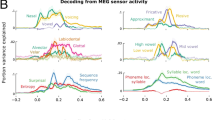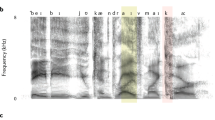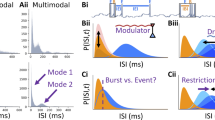Abstract
As our ability to communicate by Morse code illustrates, nervous systems can produce motor outputs, and identify sensory inputs, based on temporal patterning alone. Although this ability is central to a wide range of sensory and motor tasks, the ways in which nervous systems represent temporal patterns are not well understood. I show here that individual neurons of the lobster pyloric network can integrate rhythmic patterned input over the long times (hundreds of milliseconds) characteristic of many behaviorally relevant patterns, and that their firing delays vary as a graded function of the pattern's temporal character. These neurons directly transduce temporal patterns into a neural code, and constitute a novel biological substrate for temporal pattern detection and production. The combined activities of several such neurons can encode simple rhythmic patterns, and I provide a model illustrating how this could be achieved.
This is a preview of subscription content, access via your institution
Access options
Subscribe to this journal
Receive 12 print issues and online access
$209.00 per year
only $17.42 per issue
Buy this article
- Purchase on Springer Link
- Instant access to full article PDF
Prices may be subject to local taxes which are calculated during checkout






Similar content being viewed by others
References
Treisman, M. Temporal discrimination and the indifference interval: implications for a model of the 'internal clock'. Psychol. Monographs 77, 1–31 (1963).
Ivry, R. B. The representation of temporal information in perception and motor control. Curr. Opin. Neurobiol. 6, 851– 857 (1996).
Treisman, M., Faulkner, A., Naish, P. L. N. & Brogan, D. The internal clock: evidence for a temporal oscillator underlying time perception with some estimates of its characteristic frequency. Perception 19, 705–743 ( 1990).
Treisman, M., Faulkner, A. & Naish, P. L. N. On the relation between time perception and the timing of motor action: evidence for a temporal oscillator controlling the timing of movement. Q. J. Exp. Psychol. 45, 235–263 (1992).
Wang, D. in The Handbook of Brain Theory and Neural Networks (ed Arbib, M. A.) 967–971 (MIT Press, Cambridge, MA, 1995).
Buonomano, D. V. & Merzenich, M. M. Temporal information transformed into a spatial code by a neural network with realistic properties. Science 267, 1028– 1030 (1995).
Ivry, R. B. & Hazeltine, R. E. The perception and production of temporal intervals across a range of durations: evidence for a common timing mechanism. J. Exp. Psychol. Hum. Percept. Perform. 21, 1–12 (1995).
Abbott, L. F., Marder, E. & Hooper, S. L. Oscillating networks: control of burst duration by electrically coupled neurons. Neural Computation 3, 487–497 (1991).
De Koninck, P. & Schulman, H. Sensitivity of CaM kinase II to the frequency of Ca+2 oscillations. Science 279, 227–230 (1998).
Rezer, E. & Moulins, M. Expression of the crustacean pyloric pattern generator in the intact animal. J. Comp. Physiol. A 153, 17–28 (1983).
Sigvardt, K. A. & Mulloney, B. Properties of synapses made by IVN command-interneurones in the stomatogastric ganglion of the spiny lobster Panulirus interruptus. J. Exp. Biol. 97, 153–168 ( 1982).
Nagy, F. & Dickinson, P. S. Control of a central pattern generator by an identified modulatory interneurone in crustacea. I. Modulation of the pyloric motor output. J. Exp. Biol. 105, 33–58 (1983).
Beltz, B. et al. Serotonergic innervation and modulation of the stomatogastric ganglion of three decapod crustaceans (Homarus americanus, Cancer irroratus, and Panulirus interruptus). J. Exp. Biol. 109, 35–54 ( 1984).
Eisen, J. S. & Marder, E. A mechanism for production of phase shifts in a pattern generator. J. Neurophysiol. 51, 1375–1393 (1984).
Hooper, S. L. & Marder, E. Modulation of a central pattern generator by two neuropeptides, proctolin and FMRFamide. Brain Res. 305, 186–191 (1984).
Flamm, R. E. & Harris-Warrick, R. M. Aminergic modulation in lobster stomatogastric ganglion. I. Effects on motor pattern and activity of neurons within the pyloric circuit. J. Neurophysiol. 55, 847–865 (1986).
Harris-Warrick, R. M. & Flamm, R. E. Chemical modulation of a small central pattern generator circuit. Trends Neurosci. 9, 432–437 (1986).
Hooper, S. L. & Marder, E. Modulation of the lobster pyloric rhythm by the peptide, proctolin. J. Neurosci. 7, 2097–2112 (1987).
Nusbaum, M. P. & Marder, E. A neuronal role for a crustacean red pigment concentrating hormone-like peptide: neuromodulation of the pyloric rhythm in the crab, Cancer borealis. J. Exp. Biol. 135, 165–181 ( 1988).
Nusbaum, M. P. & Marder, E. A modulatory proctolin-containing neuron (MPN). II. State-dependent modulation of rhythmic motor activity. J. Neurosci. 9, 1600–1607 (1989).
Turrigiano, G. G. & Selverston, A. I. Cholecystokinin-like peptide is a modulator of a crustacean central pattern generator. J. Neurosci. 9, 2486–2501 (1989).
Katz, P. S. & Harris-Warrick, R. M. Actions of identified neuromodulatory neurons in a simple motor system. Trends Neurosci . 13, 367–373 ( 1990).
Turrigiano, G. G. & Selverston, A. I. A cholecystokinin-like hormone activates a feeding-related neural circuit in lobster. Nature 344, 866–868 ( 1990).
Harris-Warrick, R. M. & Marder, E. Modulation of neural networks for behavior. Annu. Rev. Neurosci. 14, 39–57 (1991).
Blitz, D. M., Christie, A. E., Marder, E. & Nusbaum, M. P. Distribution and effects of tachykinin-like peptides in the stomatogastric nervous system of the crab, Cancer borealis. J. Comp. Neurol . 354, 282–294 ( 1995).
Norris, B. J., Coleman, M. J. & Nusbaum, M. P. Pyloric motor pattern modification by a newly identified projection neuron in the crab stomatogastric nervous system. J. Neurophysiol. 75, 97–108 (1996).
Hooper, S. L. Phase maintenance in the pyloric pattern of the lobster (Panulirus interruptus ) stomatogastric ganglion. J. Computational Neurosci. 4, 191–205 (1997).
Hooper, S. L. The pyloric pattern of the lobster (Panulirus interruptus) stomatogastric ganglion comprises two phase-maintaining subsets. J. Computational Neurosci. 4, 207–219 ( 1997).
Selverston, A. I., Russell, D. F., Miller, J. P. & King, D. G. The stomatogastric nervous system: structure and function of a small neural network. Prog. Neurobiol. 7, 215– 290 (1976).
Eisen, J. S. & Marder, E. Mechanisms underlying pattern generation in lobster stomatogastric ganglion as determined by selective inactivation of identified neurons III. Synaptic connections of electrically coupled pyloric neurons. J. Neurophysiol. 48, 1392– 1415 (1982).
Russell, D. F. & Hartline, D. K. Bursting neural networks: A reexamination. Science 200, 453–456 (1978).
Hartline, D. K. Pattern generation in the lobster (Panulirus) stomatogastric ganglion. II. Pyloric network simulation. Biol. Cybern. 33, 223–236 (1979).
Miller, J. P. & Selverston, A. I. Mechanisms underlying pattern generation in lobster stomatogastric ganglion as determined by selective inactivation of identified neurons. II. Oscillatory properties of pyloric neurons. J. Neurophysiol. 48, 1378–1391 (1982).
Hartline, D. K., Gassie, D. V. & Sirchia, C. D. in The Crustacean Stomatogastric System (eds Selverston, A. I. & Moulins, M.) 75–77 (Springer, Berlin, 1987).
Golowasch, J. & Marder, E. Ionic currents of the lateral pyloric neuron of the stomatogastric ganglion of the crab. J. Neurophysiol . 67, 318–331 ( 1992).
Tierney, A. J. & Harris-Warrick, R. M. Physiological role of the transient potassium current in the pyloric circuit of the lobster stomatogastric ganglion. J. Neurophysiol. 67, 599–609 (1992).
Harris-Warrick, R. M., Coniglio, L. M., Barazangi, N., Guckenheimer, J. & Gueron, S. Dopamine modulation of transient potassium current evokes phase shifts in a central pattern generator network. J. Neurosci. 15, 342–358 (1995).
Miller, J. P. & Selverston, A. I. Rapid killing of single neurons by irradiation of intracellularly injected dye. Science 206, 702–704 (1979).
Bidaut, M. Pharmacological dissection of pyloric network of the lobster stomatogastric ganglion using picrotoxin. J. Neurophysiol. 44, 1089–1101 (1980).
Miller, J. P. & Selverston, A. I. Mechanisms underlying pattern generation in lobster stomatogastric ganglion as determined by selective inactivation of identified neurons. IV. Network properties of pyloric system. J. Neurophysiol. 48, 1416–1432 (1982).
LeMasson, G., Marder, E. & Abbott, L. F. Activity-dependent regulation of conductances in model neurons. Science 259, 1915– 1917 (1993).
Turrigiano, G., Abbott, L. F. & Marder, E. Activity-dependent changes in the intrinsic properties of cultured neurons. Science 264, 974– 977 (1994).
Turrigiano, G., LeMasson, G. & Marder, E. Selective regulation of current densities underlies spontaneous changes in the activity of cultured neurons. J. Neurosci . 15, 3640–3652 ( 1995).
Marder, E., Abbott, L. F., Turrigiano, G. G., Liu, Z. & Golowasch, J. Memory from the dynamics of intrinsic membrane currents. Proc. Natl. Acad. Sci. USA 93, 13481–13486 (1996).
Maynard, D. M. & Dando, M. R. The structure of the stomatogastric neuromuscular system in Callinectes sapidus, Homarus americanus and Panulirus argus (decapoda crustacea). Phil. Trans. R. Soc. Lond. B Biol. Sci. 268, 161– 220 (1974).
Konishi, M., Takahashi, T. T., Wagner, H., Sullivan, W. E. & Carr, C. E. in Auditory Function: Neurobiological Bases of Hearing (eds Edelman, G. M., Gall, W. E. & Cowan, W. M.) 721–745 (Wiley, New York, 1988).
Acknowledgements
I thank R. A. DiCaprio, L. G. Morris and A. L. Weaver for reading the manuscript, discussion and advice, J. B. Thuma for technical assistance and H. L. Atwood for the donation of micromanipulators. This research was supported by grants from the National Science Foundation, the Human Frontier Science Program and Ohio University and its research council.
Author information
Authors and Affiliations
Corresponding author
Rights and permissions
About this article
Cite this article
Hooper, S. Transduction of temporal patterns by single neurons. Nat Neurosci 1, 720–726 (1998). https://doi.org/10.1038/3721
Received:
Accepted:
Issue Date:
DOI: https://doi.org/10.1038/3721
This article is cited by
-
Robust dynamical invariants in sequential neural activity
Scientific Reports (2019)
-
Predicting the activity phase of a follower neuron with A-current in an inhibitory network
Biological Cybernetics (2008)
-
A computational role for slow conductances: single-neuron models that measure duration
Nature Neuroscience (2002)
-
A small-systems approach to motor pattern generation
Nature (2002)
-
He's got rhythm: single neurons signal timing on a scale of seconds
Nature Neuroscience (1998)



